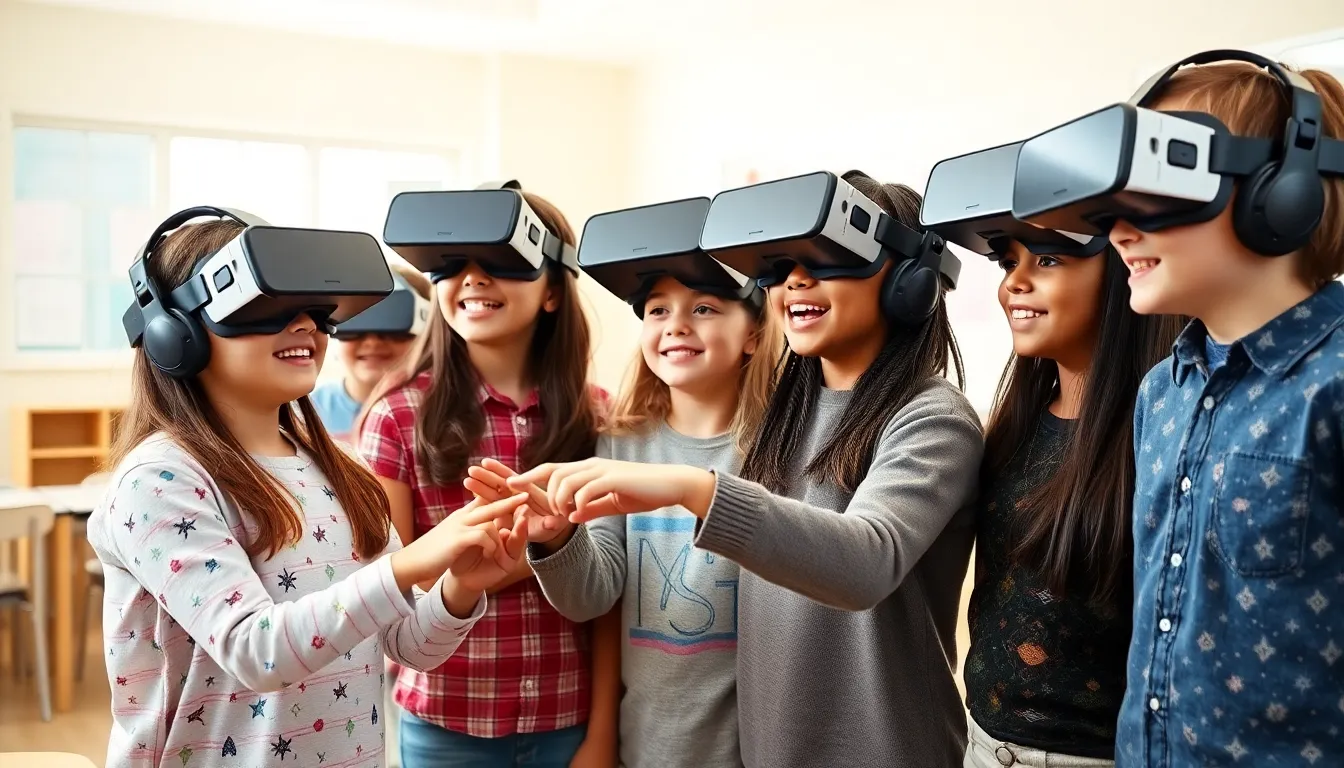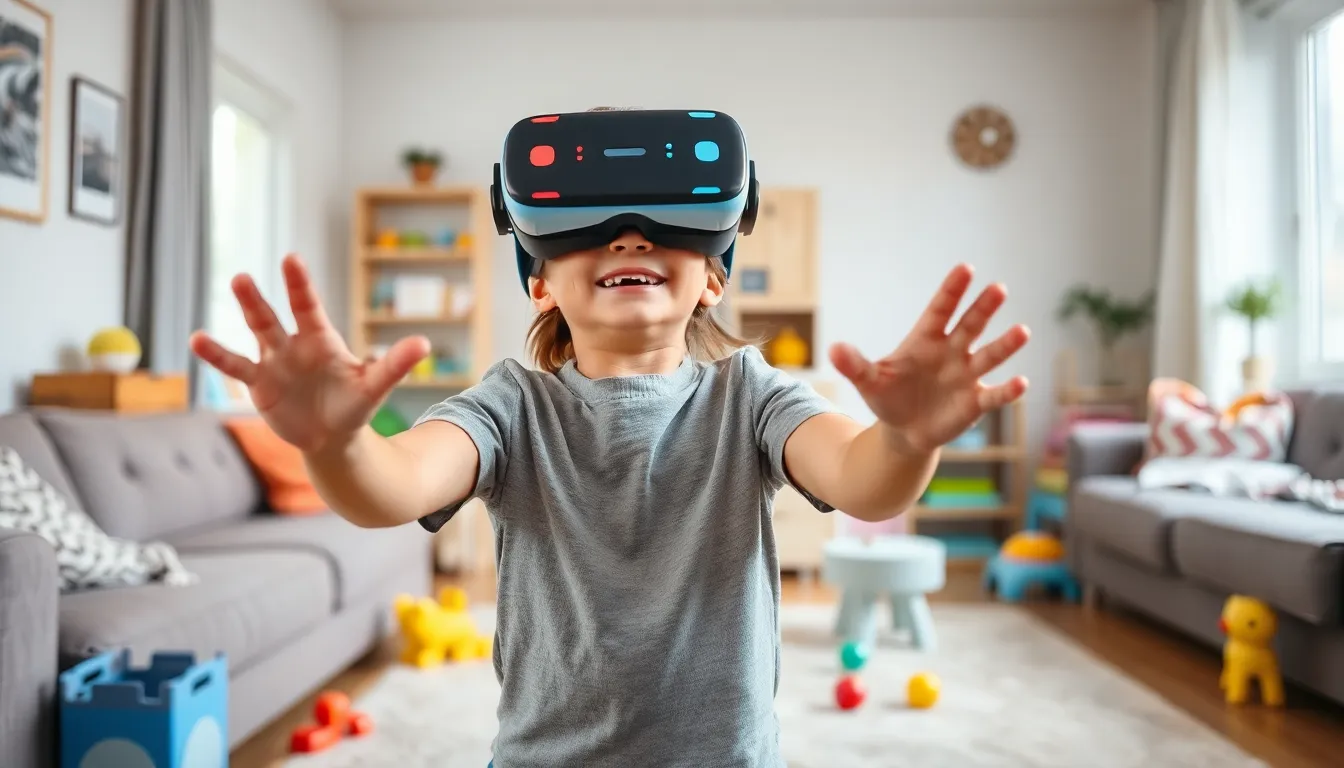Imagine a world where kids can explore distant planets, dive into the ocean’s depths, or even battle dragons—all from the comfort of their living room. Virtual reality for kids isn’t just a futuristic dream; it’s a thrilling reality that’s transforming playtime into an adventure like no other. With VR headsets becoming more accessible, children can step into immersive experiences that ignite their imaginations and fuel their curiosity.
Table of Contents
ToggleOverview of Virtual Reality for Kids
Virtual reality is an innovative tool for children’s learning and entertainment. It offers immersive experiences that engage young minds in various subjects. Kids can explore ecosystems in nature, learn about space, or practice problem-solving skills in interactive games.
Many schools integrate VR into their curricula, enhancing subjects like history and science through virtual field trips. Educational platforms designed for VR allow children to visualize complex concepts and interact with them in a three-dimensional space. This engagement makes learning more enjoyable and effective.
Parents often appreciate the benefits of VR in developing skills like hand-eye coordination and spatial awareness. Numerous studies reveal that VR can improve focus and retention, making it a valuable addition to a child’s arsenal of educational tools.
Safety is a crucial factor when it comes to VR for children. Various devices offer parental controls to monitor usage and ensure age-appropriate content. Parents can set limits on screen time, helping to balance VR experiences with other physical activities, promoting an active lifestyle.
Several popular VR games capture children’s interests across various age groups. Titles like “Job Simulator” and “Beat Saber” provide fun while enhancing cognitive skills. When children interact with these games, they acquire new skills that can assist them academically and socially.
Technology continues to evolve, leading to even more accessible and affordable VR options for families. With advancements in wireless headsets and reduced prices, experiencing virtual reality is becoming a reachable goal for many households.
Benefits of Virtual Reality for Kids

Virtual reality offers significant benefits for children, enhancing both learning and social interactions. Immersion in VR experiences fosters engagement and creativity.
Enhanced Learning Opportunities
Virtual reality transforms traditional learning methods. Educational programs use VR to teach subjects like history and science. This method allows children to embark on virtual field trips to ancient civilizations or explore the human body in three dimensions. Visualization aids comprehension, making complex ideas clearer. Students engage actively rather than passively absorbing information. Research shows that interactive learning environments lead to better retention rates. These immersive experiences create excitement around learning. Schools increasingly adopt VR tools, integrating them into curricula to enhance student engagement.
Improved Social Skills
Children develop social skills through cooperative VR experiences. Multiplayer environments encourage teamwork and communication. Players must strategize and collaborate to succeed, fostering essential interpersonal skills. VR games and activities provide opportunities for friendships to form, helping kids connect with peers in a virtual setting. Some platforms also allow for role-playing, enabling children to explore different perspectives. Such interactions break down social barriers and promote inclusivity. Enhanced social skills gained in VR environments translate into real-life interactions, boosting confidence in social situations.
Safety Considerations
Virtual reality offers immense fun for children, but parents must keep safety in mind. Careful attention to age suitability and active supervision enhances a child’sVR experience.
Age Appropriateness
Selecting age-appropriate VR content is crucial. Many VR platforms designate specific age ratings to guide parents in choosing suitable games. Children under a certain age may face developmental challenges with complex virtual environments. Additionally, content may include themes inappropriate for younger audiences. Indie developers and larger companies alike produce kid-friendly options, but parents must evaluate each choice. It’s advisable to use VR in moderation, ensuring that existing screen time guidelines align with age recommendations. The American Academy of Pediatrics suggests limited screen time for children up to 18 months, so VR usage should complement existing play activities.
Supervision and Monitoring
Parents play a vital role in monitoring VR activities. Supervision ensures children engage safely with immersive environments. Various platforms offer setting tools, enabling parents to customize experiences according to their children’s maturity levels. Regular checks on time spent using VR maintain a balance between technology and other activities. Selecting educational content can foster engagement, combining entertainment with learning. Regular discussions about experiences in virtual worlds help kids process what they see. These conversations can enhance understanding and stem any negative effects. Overall, attentive guidance encourages safe, enriching use of virtual reality.
Popular Virtual Reality Applications for Kids
Numerous virtual reality applications engage kids by combining education and entertainment. Interactive platforms like Google Expeditions allow children to explore historical landmarks and natural wonders. Through VR, students can take virtual field trips, bringing subjects like geography to life.
Another popular app, Tilt Brush, enables children to paint in a 3D space, fostering creativity and artistic expression. By moving their heads and hands, kids can create immersive art experiences that stimulate imagination.
The game Ocean Rift immerses young users in marine environments, promoting awareness of marine biology and ocean conservation. Kids can swim with dolphins or explore coral reefs, making learning about ecosystems fun.
For STEM skills, Minecraft: Education Edition brings together creativity and problem-solving. Students work cooperatively to build projects while gaining insights into engineering concepts and teamwork.
VR Education is an expanding platform offering various lessons in subjects like math and science through engaging simulations. This adaptive approach helps kids understand challenging topics, enhancing their overall learning experience.
Safety features in these applications are essential for parent peace of mind. Many VR platforms, such as Oculus, incorporate parental controls, allowing guardians to monitor content and set time limits. Age ratings help simplify content selection, ensuring that experiences match children’s maturity levels.
Research supports that virtual reality significantly impacts learning retention, making these applications valuable tools in both home and school environments. Engaging with VR applications can help kids improve cognitive skills while having fun in immersive worlds.
Virtual reality is revolutionizing how children learn and play. It opens doors to imaginative adventures and interactive learning experiences that engage young minds. As VR technology becomes more affordable and accessible, families can easily integrate it into their daily lives.
Parents play a crucial role in ensuring their children’s safe exploration of these virtual worlds. By selecting age-appropriate content and maintaining open communication about VR experiences, they can foster a positive environment for growth.
With its potential to enhance cognitive skills and promote social interaction, VR stands out as a valuable tool for both education and entertainment. Embracing this technology can lead to a richer, more engaging childhood experience.




